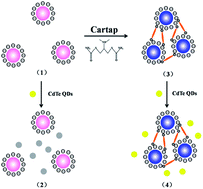Highly sensitive turn-on fluorescent detection of cartap via a nonconjugated gold nanoparticle–quantum dot pair mediated by inner filter effect
Abstract
Here, we describe a simple fluorometric assay for the highly sensitive detection of cartap on the basis of the inner filter effect (IFE) of gold nanoparticles (AuNPs) on the fluorescence of CdTe quantum dots (QDs). In the presence of AuNPs, the fluorescence of CdTe QDs was significantly quenched due to the intensive absorption of AuNPs at the 522 nm plasmon band. The well-dispersed AuNPs exhibited a tendency to aggregate when exposed to cartap with positively charged amine groups, which induced an absorption band transition from 522 nm to the long-wavelength band and restored the IFE-decreased emission of CdTe QDs for cartap detection. Under optimum conditions, the response was linearly proportional to the concentration of cartap in Chinese cabbage within the range of 0.01 to 0.50 mg kg−1 with a detection limit of 8.24 μg kg−1 (S/N = 3). Further application in cartap-spiked vegetable samples suggested a recovery between 81.9% and 90.6%. The amount of cartap in the spiked samples detected by the present method and GC-MS was in good accordance, which indicates that this IFE-based fluorescent method is reliable and practical. The proposed assay exhibited good reproducibility and accuracy, providing a simple and rapid method for the analysis of cartap.


 Please wait while we load your content...
Please wait while we load your content...